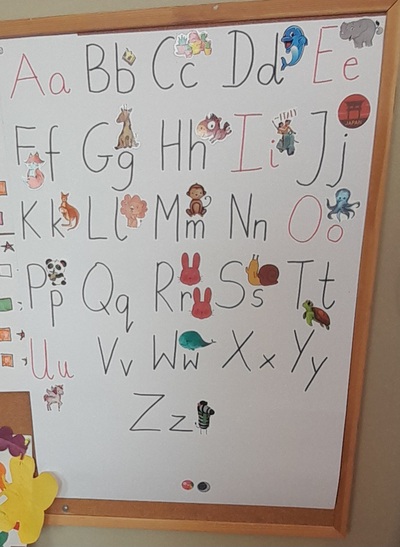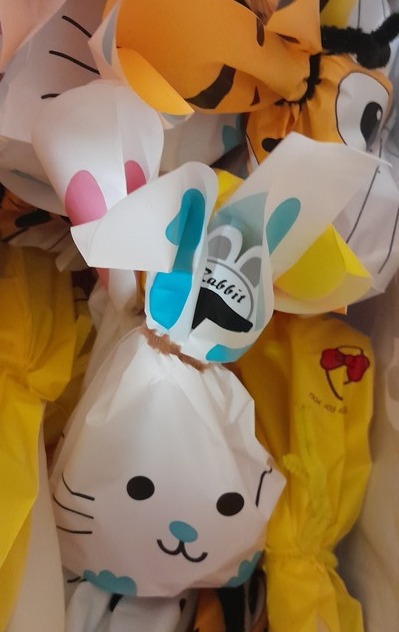
This is the second post in the series and the link between them is the painter’s scotch that already futured in the first post but that is still one of my top 5 things in my bag. And here are some more…

The alphabet
We started the academic year with ‘Aa is for apple’ in our handwriting booklets and we spent the first three months on meticulous handwriting exercises. When we got to Zz and we were more or less familiar with the whole set of letters, I would write all of them on the top of the board for the kids to copy. I know that there are a lot of posters available on the market (and my school prints their own, too), but I just didn’t like them as they did not match my set of requirements: big letters, handwriting, font matching what we have been using and some visual representation, too, to help make them a little bit less abstract. With the visuals that we already know instead of some randomness such as ‘N – nest’, ‘Q – quilt’, ‘S – sparrow’, ‘Y – yak’ or even ‘X – xylopohone’ that are either very rare, well beyond the A1 level, not child-friendly or just vile (yes, I am talking about the xylophone that has the randomest pronunciaction of ‘x’ ever).
I made my own. I made two, one for 1A and one for 1B. The only thing necessary was an A1 piece of cardboard, a marker and a set of stickers.
It has spent the second half of the year on the walls of our classrooms and we used it as a reference point in all our writing exercises. The kids used it on their own and I used it, too, to direct them towards the correct letter. ‘Dd is for dog! Look!’. All in all, it helped us made huge progress with our literacy skills. No more than that but so much!

The chalk markers
When I found the Treasure of the Year, I was looking for something else entirely. I was getting ready for the Art classes, White on Black, googling for black drawing paper and white pencils. I found them and the lesson was great (you can read about it here) but what I also found the Solution of the Year and the Teacher’s Love of the Year: the chalk markers.
The thing is for the previous six months I had been forced to use the traditional blackboard and the traditional chalk and I hated every single moment of it, after all my educational like in the Polish state schools, fourteens years as a student and five as a teacher; hatred from the very bottom of my heart, because of the dry hands, because of the chalk dust on your clothes and because of the cloth. And then I found the chalk markers that I had not even known existed!
They are beyond amazing. They last a few weeks, they are just markers and they are quite thin so it is a dream to be writing with them and you can be very accurate and produce intricate letters and drawings. And they erase easily!

The trolley
I spent about three weeks of the academic year being miserable. I had two groups and two classrooms and the whole day was about moving from one to the other, together with everything that I needed in my teaching life: markers, toys, flashcards, cards, stamps, schoolbag, thermos, notebook, my magic wand, glue, craft paper, pencils…Most of the time wasting on it the entire length of the break. Every single time, every single day. The classrooms are door to door but, still, it meant making a few rounds, a few times a day. It’s not that I did not have a place to keep my things in either of these classrooms, I did, but it was still impossible to have two separate sets of cards, two separate sets of puppets, two separate sets of markers for the whole class.
The misery lasted almost a month until I had enough and I looked for solutions. I used to use boxes and baskets in the past, with my preschoolers but these would not work in these new circumstances. This is how I got my trolley, four metal shelves of happiness on wheels. Each shelf has its own theme and I keep there, going from the top: markers, flashcards and storybooks and puppets, cards, packets small scrap paper cards and handmade cards.
It is super easy to move from one classroom to the other or to roll it around the classroom while handing out boxes with markers. It is light so my students can help with it and they love doing it. They actually love to pretend play being flight attendants and giving out things. It made my life much easier.
One more thing! That trolley is getting me one step closer to becoming a Real Babushka!

The cupboards
One thing that I definitely had a chance to find out about myself is that I am thoroughly obsessed with order. It might have something to do with some form of OCD because mess and disorder makes me very unhappy. In the past, I must have lived in some kind of an ignorance but that’s because I was not obliged to share the classroom with another teacher on permanent basis. Until September 2023.
This was when I realised that I am deeply unhappy with the disorder on the table, on the cupbards, on the window sills and on the shelves. This was when I understood that I like my classroom near to empty, without all of these toys, games, books and (omg) candy that children have a full and unrestricted access to, which, of course, has a detrimental impact on the general classroom management. Alas, when you have to share, you just share and try to live to tell the story.
The cupboards made it possible and because there are two that I have got, I can be easy-going with how I organise the shelves and what I put things. In one word, I have room for everything. One full cupboard is filled with books, workbooks and notebooks and the other is my beloved Art cupboard, with all my resources, treasures, aprons and jars. They are all located at the back of the classroom and sometimes, when I teach, I like to glance at one or the other and smile. Peace and quiet, law and order in my resources.

The markers
There are many stationary items in the primary classroom, pencils, pens, crayons, coloured pencils but ‘Nothing compares to you’ is what I would sing to my boxes of markers. I think, perhaps, it might be because of the hours spent in the young learners’ and very young learners’ classroom or, in other words, because of the hours spent with people who are learning to hold a writing tool and people who are learning to use it to write their first words.
On behalf of my students, I prefer them to everything else, because, first of all, they are much easier to handle for an inexperienced hand, much easier to hold, requiring less muscle power to hold and to produce a line, very often much thicker and much lighter than anything else. Not to mention that because of the colours and the excitement of using them, they make the difficult and tiresome task of writing a tiny little bit more appealing and motivating.
We use them throughout the year to colour and, also, in the beginning of the year to write. I cannot really say exactly when we stop and switch to pencils and pens as it varies, from year to year but that is our general procedure.
Happy teaching!


















